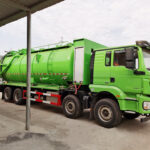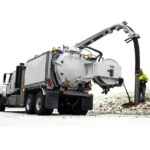The Unforgiving Operational Landscape of Waste Collection
Self-tipping garbage trucks operate within some of the most demanding conditions in municipal services, navigating narrow residential streets before dawn, enduring corrosive leachate exposure, and performing hundreds of high-force lifting cycles daily under extreme temperature variations from frozen winters to scorching summers. Single-point hydraulic system failures during a lift cycle can cascade into catastrophic outcomes: partially elevated containers crashing onto vehicles or infrastructure, hydraulic oil spills contaminating storm drains, or stranded trucks paralyzing collection routes for hours. The financial calculus is brutal—a single aborted route from hydraulic failure costs municipalities upwards of $8,000 in overtime wages, contractor penalties, and emergency cleanup, not accounting for liability claims from traffic obstructions or environmental incidents. Unlike passenger vehicles where redundancy is a luxury, these workhorses demand hydraulic redundancy as an operational non-negotiable because failure doesn’t merely inconvenience—it halts an essential public health service with immediate urban consequences.
Anatomy of Fail-Safe Hydraulic Architectures
Modern self-tippers incorporate multi-layered hydraulic redundancy systems engineered to maintain partial or full functionality during component failures:
Primary and Secondary Power Sources
The core redundancy begins with dual-circuit pump systems where tandem gear pumps operate in parallel, each capable of independently powering the lift mechanism should the other fail. Advanced systems incorporate pressure-compensated variable displacement pumps that instantly reroute fluid through crossover relief valves, maintaining 70% operational capacity even with complete pump seizure. Parker Hannifin’s R7 Series, for instance, integrates failsafe solenoids that automatically isolate damaged circuits while activating secondary reservoirs.
Distributed Control Intelligence
Electrohydraulic systems now embed modular valve blocks with cross-communication capabilities, allowing valve spools to reassign functions dynamically during faults. Bosch Rexroth’s SYDFE system exemplifies this, using CANbus-enabled sensors to detect pressure drops below 2,000 psi within 15 milliseconds, triggering redundant valves to assume control without operator intervention. This distributed intelligence transforms potential failure points into coordinated networks where components collaboratively bypass compromised sections.
The Maintenance Paradox – Designing for Resilience Amid Neglect
Municipal fleet managers face a harsh reality: garbage trucks rank lowest in preventive maintenance compliance despite operating under the highest mechanical stress. Hydraulic redundancy systems counter this through:
- Self-diagnostic hydraulics with real-time fluid analysis sensors detecting viscosity changes or particulate contamination at 50ppm, alerting technicians before degradation cascades
- Graceful degradation protocols enabling operation in “limp mode”—reduced lifting speed but maintained functionality—when contaminants compromise primary systems
- Dual-reservoir designs with partitioned fluid chambers isolating metal shavings or moisture infiltration to a single reservoir, preserving 80% fluid integrity
These features acknowledge operational realities where trucks may operate 12 weeks between scheduled services, transforming potential breakdowns into managed performance reductions until repairs occur.
Quantifying Failure Scenarios – When Redundancy Becomes the Last Line of Defense
Consider these actual failure scenarios mitigated solely through hydraulic redundancy:
- Detroit, January 2024: A fractured main lift cylinder during -20°F operations triggered secondary accumulators to complete the lift cycle, preventing a 9-ton container from collapsing onto a parked school bus. Redundancy saved an estimated $410,000 in property damage and litigation.
- Brisbane, March 2025: Simultaneous pump seizure and valve block contamination during a heatwave event were overcome by electrohydraulic power take-off (ePTO) systems, which engaged auxiliary pumps within 8 seconds, thereby avoiding a hydraulic fluid spill into sensitive wetlands.
- Toronto, July 2023: Corroded main lines burst during a residential collection, but automatic flow-diverting valves contained 94% of fluid while maintaining partial lift functionality via secondary circuits.
Each incident demonstrates how redundant architectures transform potential disasters into manageable incidents—often unnoticed by residents—preserving both operational continuity and municipal reputations.
The Evolutionary Trajectory – From Trucks to Integrated Smart Waste Systems
Hydraulic redundancy now extends beyond mechanical backups into predictive cyber-physical systems. Next-generation trucks incorporate digital twin simulations that mirror hydraulic performance in real-time, anticipating failures weeks in advance by analyzing micro-vibrations and pressure pulsations. Cloud-connected systems automatically order replacement filters or seals when algorithms detect deviations exceeding ISO 4406 cleanliness thresholds. Crucially, these principles are revolutionizing broader waste infrastructure:
- Compactor trucks now deploy triple-redundant rams with independent pressure sensors, ensuring continuous compaction force even during cylinder seal blowouts
- Advanced vacuum truck fleets utilize segregated vacuum and discharge circuits with fallback ejector systems, preventing sewage backflow during power loss
- Transfer stations integrate AI-driven hydraulic health monitoring that cross-references data across entire fleets, identifying systemic weaknesses before failures occur
This evolution positions hydraulic redundancy not as isolated engineering, but as the critical enabler of truly resilient urban waste ecosystems capable of adapting to escalating climate pressures.







